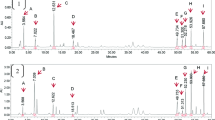Abstract
Bee propolis is a sticky amalgamation of plant resins collected by honeybees (Apis mellifera L.) and used in the hive for filling cracks and repairing combs. Propolis contains a diversity of compounds of plant origin, and is reported to have medicinal, antimicrobial, insecticidal, and phytotoxic properties. We examined the physical and chemical composition of North American samples of bee propolis from several sites in North America and tested for bioactivity against larvae of the greater wax moth (Galleria mellonella L.), a common apiary pest. The amount of methanol-extractable resin in samples from Ohio and Georgia ranged from 24% to 79% by weight. Propolis collected from hives in Ohio was more chemically diverse (over 30 compounds detected by paper chromatography) than material from south Georgia (fewer than 10 major compounds) and contained a lower proportion of methanol-insoluble beeswax. The paper chromatographic surveys revealed little variation in the chemical profile of specific hives over a six-month period and no differences between propolis from adjacent hives. Four flavonoids were identified from propolis collected in Ohio: kaempferol, galangin, 3,3′-dimethoxyquercetin and 3-methoxykaempferol. When mixed into artificial diet, fractionated propolis reduced larval growth of the greater wax moth, but not dramatically. An array of phenolics reported from propolis (caffeic acid, chrysin, ferulic acid, galangin, kaempferol, and quercetin) were bioassayed individually for effects on larvae, but none reduced larval growth at the concentrations tested, suggesting that wax moths are tolerant of some phenolics in their diet.
Similar content being viewed by others
References
Bankova, V.S., Popov, S.S., andMarekov, N.L. 1982. High performance liquid chromatographic analysis of flavonoids from propolis.J. Chromatogr. 242:135–143.
Bankova, V.S., Popov, S.S., andMarekov, N.L. 1983. A study on flavonoids of propolis.J. Nat. Prod. 46:471–474.
Bernays, E.A., andWoodhead, S. 1982. Plant phenols utilized as nutrients by a phytophagous insect.Science 216:201–203.
Eischen, F., andDietz, A. 1987. Growth and survival ofGalleria mellonella (Lepidoptera: Pyralidae) larvae fed diets containing honey bee-collected plant resins.Ann. Entomol. Soc. Am. 80:74–77.
Ghisalberti, E.L. 1979. Propolis: A review.Bee World 60:59–84.
Harborne, J.B., Mabry, T.J., andMabry, H. (eds.). 1975. The Flavonoids. Chapman and Hall, London.
Isman, M.B., andDuffy, S.S. 1983. Pharmacokinetics of chlorogenic acid and rutin in larvae ofHeliothis zea.J. Insect Physiol. 29:295–300.
Jay, M., Gonnet, F., Wollenweber, E., andVoirin, B. 1975. Sur l'analyse qualitative des aglycones flavoniques dans une optique chimiotaxinomique.Phytochemistry 14:1605–1612.
Kato, M. 1978. Phenols as indispensable components of the synthetic diet of the silkworm,Bombyx mori.Entomol. Exp. Appl. 24:285–290.
Levin, D.A. 1976. The chemical defenses of plants to pathogens and herbivores.Annu. Rev. Ecol. Syst. 7:121–159.
Lindenfelser, L.A. 1967. Antimicrobial activity of propolis.Am. Bee J. 107:90–92; 130–131.
Mabry, J.T., Markham, K.R., andThomas, M.B. 1970. The Systematic Identification of Flavonoids. Springer-Verlag, Berlin.
Maciejewicz, W., Daniewski, M., andMielniczuk, Z. 1985. Gas chromatography-mass spectrometry investigation of propolis. Analysis of phenolic acids and sugars.Chem. Anal. 29:421–427.
Markham, K.R. 1982. Techniques of Flavonoid Identification. Academic Press, London.
McFarlane, J.E., andDistler, M.H.W. 1982. The effect of rutin on growth, fecundity and food utilization inAcheta domesticus (L.).J. Insect Physiol. 28:85–88.
Meyer, W. 1956. Propolis bees and their activities.Bee World 37:25–36.
Nenov, V., Mollova, N., Demirev, P., Bankova, V., andPopov, S. 1983. Computer assisted mass-spectral investigation of flavonoid mixtures.Int. J. Mass Spectrom. Ion Phys. 47:333–336.
Pepelinjak, S., Jalsenjak, I., andMaysinger, D. 1985. Flavonoid content in propolis extracts and growth inhibition ofBacillus subtilis.Pharmazie 40:122–123.
Popravdo, S.A. 1977. The chemico-taxonomic study of propolis.Pchelovodstvo 2:27–29.Apicultural Abstracts 1356/79.
Popravdo, S.A., Sokolov, I.V., andTorgov, I.V. New natural phenolic triglycerides. Translated from Khimiya Prirodnykh Soedineii, No. 2, pp. 169–173, March–April, 1982.Chem. Nat. Compd. 18:153–157.
Schneidewind, E.M., Kala, H., Linzer, B., andMetzner, J. 1975. Zur kenntnis der inhaltsstoffe von propolis.Pharmazie 30:803.Apicultural Abstracts 292/79.
Serkedjieva, J., Manolova, N., andBankova, B. 1992. Anti-influenza virus effect of some propolis constituents and their analogues (esters of substituted cinnamic acids).J. Nat. Prod. 55:294–297.
Shaver, T.N., andLukefahr, M.J. 1969. Effect of flavonoid pigments and gossypol on growth and development of the bollworm, tobacco budworm, and pink bullworm.J. Econ. Entomol. 62:643–646.
Stahl, E. 1969. TLC—A Laboratory Handbook, 2nd 3d. Springer-Verlag, Berlin.
Steel, R.G.D., andTorrie, J.H. 1960. Principles and Procedures of Statistics. McGraw-Hill, New York.
Author information
Authors and Affiliations
Rights and permissions
About this article
Cite this article
Johnson, K.S., Eischen, F.A. & Giannasi, D.E. Chemical composition of North American bee propolis and biological activity towards larvae of greater wax moth (Lepidoptera: Pyralidae). J Chem Ecol 20, 1783–1791 (1994). https://doi.org/10.1007/BF02059899
Received:
Accepted:
Issue Date:
DOI: https://doi.org/10.1007/BF02059899




